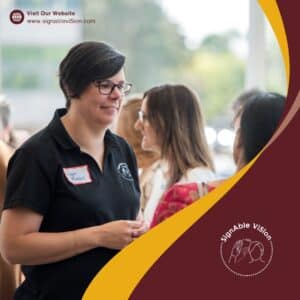I’m excited to share that I have received my Rick Hansen Foundation Accessibility Certification Fundamental Training Award! This training has reinforced what I’ve always believed: accessibility should be built-in, non-negotiable, and standard everywhere – not an afterthought or a special accommodation.
As a Deaf person, I encounter barriers every day. Poor signage, unclear emergency exits, and spaces designed without considering Deaf or disabled people create real exclusion, not just inconvenience. One of my biggest takeaways from this course is how inconsistent accessibility is across different buildings. Some places barely meet legal requirements, while others go above and beyond, but access shouldn’t depend on how much an organization “cares.” It should be required, enforced, and uniform in building codes everywhere.
Currently, the accessibility requirements that contractors and architects follow are based on basic checklists; they only meet minimum compliance. But accessibility needs to go further. RHF pushes beyond these basic standards, setting a higher bar for inclusive design by emphasizing barrier-free environments that allow independent access for all. Instead of just checking compliance boxes, RHF promotes a holistic, user-first approach to accessibility, ensuring spaces are designed to be truly inclusive from the start.
Did you know that it only costs 1% more to include accessibility if it’s planned from the beginning? Yet, when accessibility is ignored and added later, the costs and barriers increase significantly. This is why it’s critical to incorporate accessibility into every stage of design and construction.
This course touched on Deaf accessibility but not in depth. That’s where my expertise comes in. True accessibility isn’t just about ramps and elevators; it must include communication access as well. Many spaces still fail to provide visual alerts, captioning, or proper sign language accommodations. Without these, Deaf individuals remain excluded from full participation.
This course equipped me with the tools to assess accessibility beyond a checklist; it’s not just about ticking boxes, but about whether people can independently and equitably use a space. True accessibility means everyone belongs, without barriers to communication, navigation, or participation.
Moving forward, I’m expanding my advocacy beyond communication access. I’ve always worked with organizations on ASL training and workplace inclusion, but now I’ll challenge them to consider the physical environment too. Do their spaces truly support Deaf and disabled people? Can we navigate, interact, and feel included? Hiring an interpreter is great—but is the space itself accessible?
When consulting with businesses, I’ll push for meaningful accessibility improvements, such as:
✅ Visual alarms for emergency alerts
✅ Clear, readable signage and wayfinding
✅ Universally designed spaces that benefit everyone, not just those with disabilities
✅ Consistent inclusion of Deaf perspectives in accessibility planning
This course reinforced what I’ve always known: accessibility is a right, not a privilege. But now, I have a stronger framework to push for real change. I envision a world where we don’t have to fight for access, because it’s already built in. That starts with stronger, uniform building codes that prioritize people over compliance.
If you’re an organization, venue, or business looking to improve accessibility, let’s talk! Deaf inclusion goes beyond checking a box, let’s build environments that work for everyone. Contact me to integrate Deaf accessibility into your planning and training.



